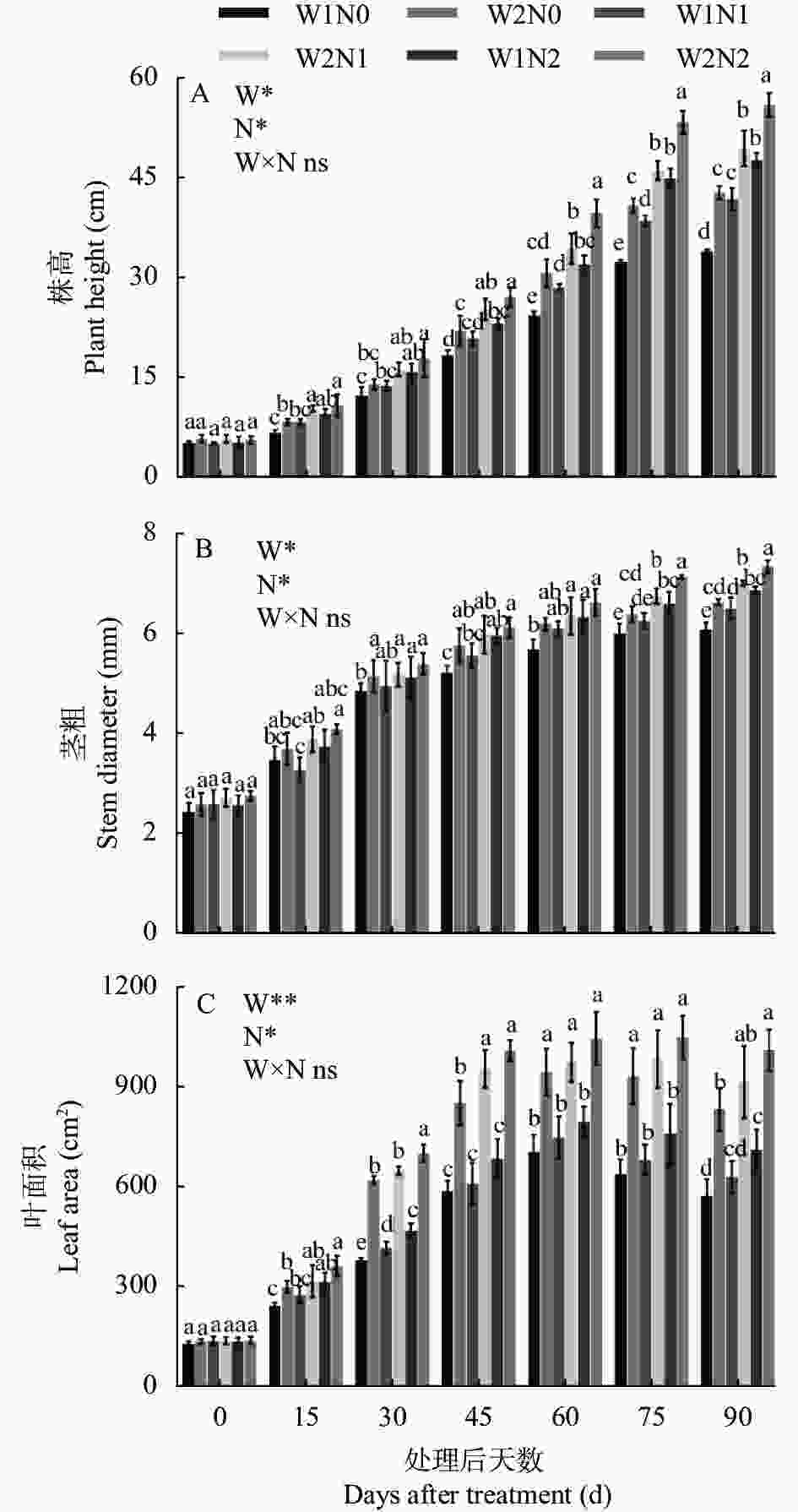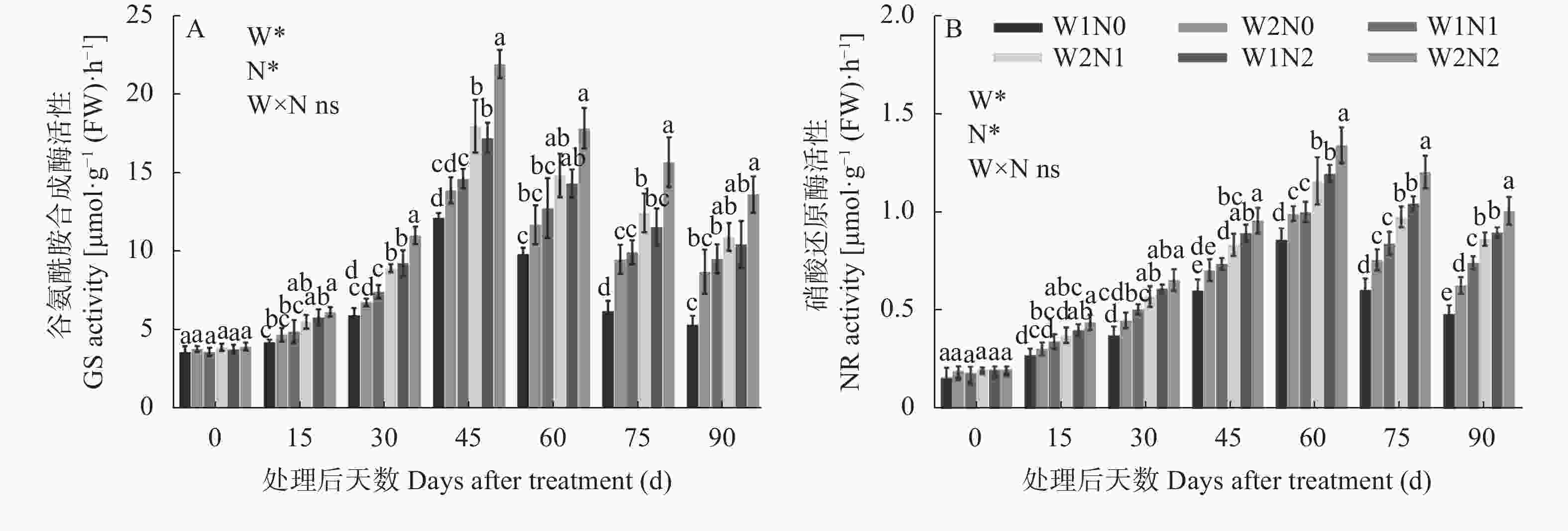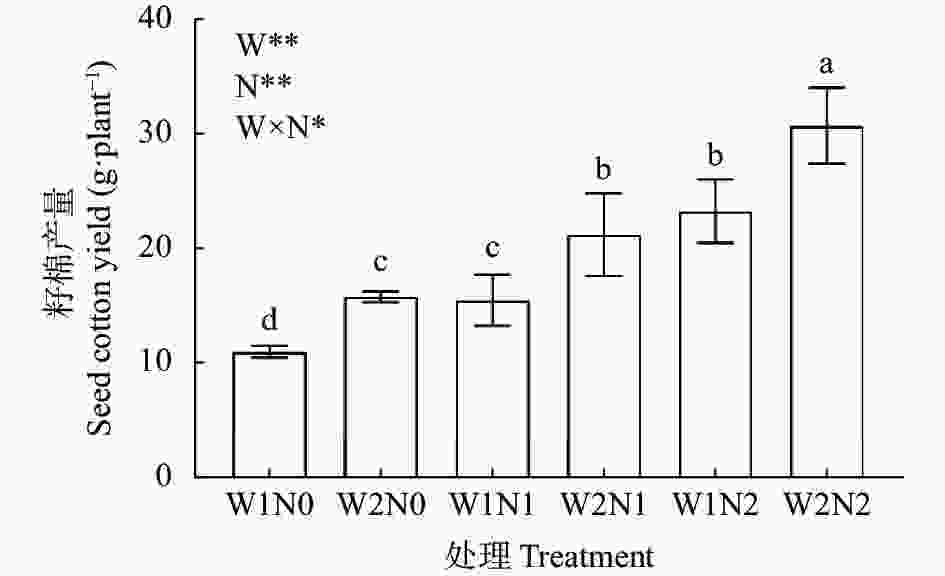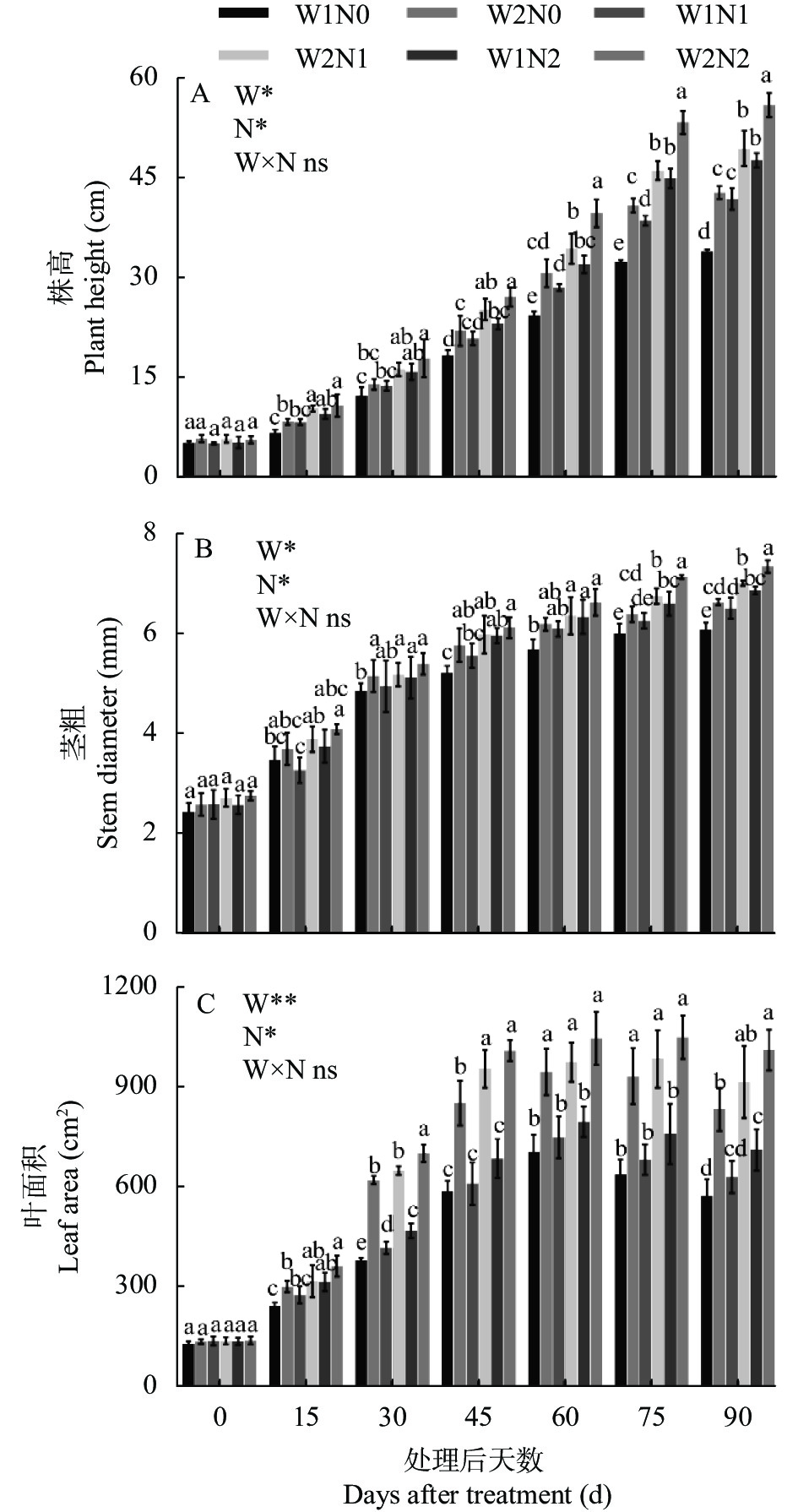Effects of water and nitrogen regulation on physiological characteristics and yield of cotton
-
摘要: 水分和氮素是影响棉花生长发育和产量的主要因子, 为探究水分和氮素对棉花形态、生理特性以及产量的调控效应, 本研究以‘农大棉36号’为材料, 设置干旱胁迫(W1, 相对含水量为45%±5%)和正常供水(W2, 相对含水量为70%±5%)两个水分条件以及不施氮肥(N0)、低氮[N1, 69 mg(N)∙kg−1]、常规施氮[N2, 138 mg(N)∙kg−1] 3个氮素水平, 分析不同水分和氮肥条件下棉花地上部和根系形态、光合性状、抗氧化酶活性、氮代谢酶活性以及产量的变化。结果表明, 与W2处理相比, W1处理显著抑制了棉花生长, 降低了棉花株高、茎粗、叶面积以及总根长、总根表面积、平均根直径(P<0.05), 显著增加了超氧化物歧化酶(SOD)、过氧化物酶(POD)、过氧化氢酶(CAT)活性, 降低了相对叶绿素含量(SPAD)、最大光化学效率(Fv/Fm)和光合能力, 从而造成棉花产量下降(P<0.05); 与N2处理相比, N0和N1处理上述指标均显著降低。干旱胁迫下, 常规施氮处理比不施氮肥和低氮处理促进棉花地上和地下生长, 显著提高主茎叶SPAD、净光合速率和Fv/Fm (P<0.05), 增强抗氧化酶(SOD、POD、CAT)和氮代谢酶(GS和NR)活性(P<0.05), 减轻干旱胁迫对棉花生长造成的抑制, 提高棉花产量。在低氮条件下, 正常供水比干旱胁迫处理亦促进棉花的生长, 增强光合作用和氮代谢酶活性, 减缓了低氮胁迫对其产生的不利影响, 提高产量(P<0.05)。因此, 可通过增施氮肥提高干旱胁迫下的棉花产量, 亦可通过适当增加灌水量提高低氮胁迫下的棉花产量, 本研究为明确氮素胁迫和水分胁迫下合理的水肥管理提供了理论依据。Abstract: Water and nitrogen are the main factors affecting the growth, development, and yield of cotton. In this study, “Nongda Cotton No. 36” was selected to investigate the effects of water and nitrogen on morphology, physiological characteristics, and yield of cotton. Two water conditions were set: drought stress (W1, relative water content was 45%±5%) and normal water supply (W2, relative water content was 70%±5%), and three nitrogen levels: no nitrogen (N0), low nitrogen [N1, 69 mg(N)∙kg−1], and normal nitrogen fertilizers [N2, 138 mg(N)∙kg−1]. Changes in aboveground and root morphology, photosynthetic characteristics, antioxidant enzyme activity, nitrogen metabolism enzyme activity, and cotton yield were analyzed under different water and nitrogen fertilizer conditions. The results showed that compared with the W2 treatments, the W1 treatments significantly inhibited cotton growth and decreased plant height, stem diameter, leaf area, total root length, total root surface area, and average root diameter (P<0.05). The activities of superoxide dismutase (SOD), peroxidase (POD), and catalase (CAT) were significantly enhanced, the relative chlorophyll content (SPAD) and maximum photochemical efficiency (Fv/Fm) were decreased, and the photosynthetic capacity was weakened, resulting in a decrease in cotton yield (P<0.05). Compared with the N2 treatments, the N0 and N1 treatments significantly reduced plant height, stem diameter, leaf area, total root length, total root surface area, and average root diameter of cotton (P<0.05). The activities of SOD, POD, CAT, glutamine synthetase (GS), nitrate reductase (NR), SPAD, and Fv/Fm in cotton were significantly decreased under the N0 and N1 treatments, and the photosynthetic capacity of cotton was weakened. Thus, the cotton yield decreased (P<0.05). Under drought stress, conventional nitrogen application promoted the growth of the aboveground and underground parts of cotton; significantly increased the SPAD, net photosynthetic rate, and Fv/Fm in main-stem leaves (P<0.05); and enhanced the activities of antioxidant enzymes (SOD, POD, and CAT) and nitrogen metabolism enzymes (GS and NR) (P<0.05), which alleviated the damage caused by drought stress and increased the cotton yield. Under low-nitrogen conditions, the normal water supply treatment promoted the growth of cotton; enhanced photosynthesis, nitrogen metabolism enzyme activities, and yield (P<0.05); and alleviated the adverse effects of low-nitrogen stress on cotton. Therefore, cotton yield under drought stress can be increased by increasing nitrogen fertilizer, and cotton yield under low-nitrogen stress can be increased by appropriately increasing irrigation water. The results provide a theoretical basis for clarifying rational water and fertilizer management of cotton under nitrogen and water stresses.
-
图 1 水分和氮素对棉花株高(A)、茎粗(B)以及叶面积(C)的影响
W1: 相对含水量为45%±5%; W2: 相对含水量为70%±5%; N0: 不施氮肥; N1: 施氮69 mg(N)·kg−1; N2: 施氮138 mg(N)·kg−1。不同小写字母表示同一时间不同处理间在P<0.05水平差异显著。ns表示未达到显著水平, *代表P<0.05显著水平, **代表达P<0.01极显著水平。W1: relative water content of 45%±5%; W2: relative water content of 70%±5%; N0: no nitrogen fertilizer; N1: nitrogen application rate of 69 mg(N)·kg−1; N2: nitrogen application rate of 138 mg(N)·kg−1. Different lowercase letters above the bars indicate significant differences at P<0.05 level among treatments in the same date. ns means no significant difference. * means signifi-cant differences at P<0.05 level. ** means significant differences at P<0.01 level.
Figure 1. Effects of water and nitrogen regulation on plant height (A), stem diameter (B) and leaf area (C) of cotton
图 2 水分和氮素调控对棉花总根长(A)、总根表面积(B)以及平均根直径(C)的影响
W1: 相对含水量为45%±5%; W2: 相对含水量为70%±5%; N0: 不施氮肥; N1: 施氮69 mg(N)·kg−1; N2: 施氮138 mg(N)·kg−1。不同小写字母表示不同处理间在P<0.05水平差异显著。ns表示未达到显著水平, *代表P<0.05显著水平, **代表P<0.01极显著水平。W1: relative water content of 45%±5%; W2: relative water content of 70%±5%; N0: no nitrogen fertilizer; N1: nitrogen application rate of 69 mg(N)·kg−1; N2: nitrogen application rate of 138 mg(N)·kg−1. Different lowercase letters above the bars indicate significant differences at P<0.05 level among treatments. ns means no significant difference. * means significant differences at P<0.05 level. ** means significant differences at P<0.01 level.
Figure 2. Effects of water and nitrogen regulation on total root length (A), total root surface area (B) and average root diameter (C) of cotton
图 3 水分和氮素调控对棉花谷氨酰胺合成酶活性(A)和硝酸还原酶活性(B)的影响
W1: 相对含水量为45%±5%; W2: 相对含水量为70%±5%; N0: 不施氮肥; N1: 施氮69 mg(N)·kg−1; N2: 施氮138 mg(N)·kg−1。不同小写字母表示同一时间不同处理间在P<0.05水平差异显著。ns表示未达到显著水平, *代表P<0.05显著水平, **代表P<0.01极显著水平。W1: relative water content of 45%±5%; W2: relative water content of 70%±5%; N0: no nitrogen fertilizer; N1: nitrogen application rate of 69 mg(N)·kg−1; N2: nitrogen application rate of 138 mg(N)·kg−1. Different lowercase letters above the bars indicate significant differences at P<0.05 level among treatments in the same date. ns means no significant difference. * means significant differences at P<0.05 level. ** means significant differences at P<0.01 level.
Figure 3. Effects of water and nitrogen regulation on activities of glutamine synthetase (GS, A) and nitrate reductase (NR, B) in cotton
图 4 水分和氮素调控对棉花籽棉产量的影响
W1: 相对含水量为45%±5%; W2: 相对含水量为70%±5%; N0: 不施氮肥; N1: 施氮69 mg(N)·kg−1; N2: 施氮138 mg(N)·kg−1。不同小写字母表示不同处理间在P<0.05水平差异显著。ns表示未达到显著水平, *代表P<0.05显著水平, **代表P<0.01极显著水平。W1: relative water content of 45%±5%; W2: relative water content of 70%±5%; N0: no nitrogen fertilizer; N1: nitrogen application rate of 69 mg(N)·kg−1; N2: nitrogen application rate of 138 mg(N)·kg−1. Different lowercase letters above the bars indicate significant differences at P<0.05 level among treatments. ns means no significant difference. * means significant differences at P<0.05 level. ** means significant differences at P<0.01 level.
Figure 4. Effects of water and nitrogen regulation on cotton seed yield
表 1 水分和氮素调控对棉花相对叶绿素含量(SPAD)的影响
Table 1. Effects of water and nitrogen regulation on relative chlorophyll content (SPAD) of cotton
处理
Treatment处理后天数 Days after treatment (d) 0 15 30 45 60 75 90 W1N0 42.33±0.50a 42.97±0.85e 41.20±0.26d 35.63±0.75e 30.87±0.68e 25.73±1.37e 20.33±1.25d W2N0 43.07±0.95a 46.00±0.46cd 43.67±0.59c 40.70±0.85c 35.87±0.85d 32.47±1.86d 28.43±0.68c W1N1 42.57±0.74a 45.10±0.26d 42.30±1.01cd 38.67±0.38d 34.93±0.32d 31.23±1.23d 26.37±0.87c W2N1 43.00±1.15a 47.53±0.95b 50.77±0.57b 45.60±0.46b 42.40±0.60b 40.53±1.19b 36.97±1.16b W1N2 43.10±0.70a 46.63±0.65bc 49.27±1.04b 44.27±0.95b 40.67±0.50c 37.77±0.99c 34.77±0.81b W2N2 42.90±1.11a 49.33±0.93a 55.27±0.95a 50.53±0.86a 47.43±0.47a 44.67±1.20a 41.90±1.41a 水分 Water (W) ns ** ** ** ** ** ** 施氮 Nitrogen application (N) ns ** ** ** ** ** ** 水分×氮肥 W×N ns ns ** * * ns * W1: 相对含水量为45%±5%; W2: 相对含水量为70%±5%; N0: 不施氮肥; N1: 施氮69 mg(N)·kg−1; N2: 施氮138 mg(N)·kg−1。同列不同小写字母表示同一时间不同处理间在P<0.05水平差异显著。ns表示未达到显著水平, *代表P<0.05显著水平, **代表P<0.01极显著水平。W1: relative water content of 45%±5%; W2: relative water content of 70%±5%; N0: no nitrogen fertilizer; N1: nitrogen application rate of 69 mg(N)·kg−1; N2: nitrogen application rate of 138 mg(N)·kg−1. Different lowercase letters in the same column indicate significant differences at P<0.05 level among treatments in the same date. ns means no significant difference. * means significant differences at P<0.05 level. ** means significant differences at P<0.01 level. 表 2 水分和氮素调控对棉花净光合速率的影响
Table 2. Effects of water and nitrogen regulation on net photosynthetic rate of cotton
µmol·m−2·s−1 处理
Treatment处理后天数 Days after treatment (d) 0 15 30 45 60 75 90 W1N0 11.65±0.66a 11.04±0.20d 10.31±0.19d 9.99±0.47c 8.94±0.36d 8.21±0.18d 7.79±0.15c W2N0 11.61±0.70a 11.73±0.21c 11.06±0.14c 10.65±0.37bc 9.88±0.14c 9.54±0.52c 9.19±0.04b W1N1 11.90±0.15a 11.42±0.40cd 10.97±0.26c 10.50±0.45bc 9.73±0.08c 9.43±0.19c 9.08±0.11b W2N1 11.99±0.29a 12.37±0.36b 11.96±0.20b 11.17±0.17b 10.58±0.30b 10.14±0.08b 9.63±0.50b W1N2 12.09±0.40a 11.79±0.33c 11.30±0.33c 10.96±0.40b 10.37±0.37b 10.04±0.07b 9.51±0.39b W2N2 12.13±0.19a 13.51±0.46a 13.10±0.40a 12.51±0.26a 11.87±0.21a 11.20±0.25a 10.65±0.22a 水分 Water (W) ns ** ** ** ** ** ** 施氮 Nitrogen application (N) ns ** ** ** ** ** ** 水分×氮肥 W×N ns * * ns * ns ns W1: 相对含水量为45%±5%; W2: 相对含水量为70%±5%; N0: 不施氮肥; N1: 施氮69 mg(N)·kg−1; N2: 施氮138 mg(N)·kg−1。同列不同小写字母表示同一时间不同处理间在P<0.05水平差异显著。ns表示未达到显著水平, *代表P<0.05显著水平, **代表P<0.01极显著水平。W1: relative water content of 45%±5%; W2: relative water content of 70%±5%; N0: no nitrogen fertilizer; N1: nitrogen application rate of 69 mg(N)·kg−1; N2: nitrogen application rate of 138 mg(N)·kg−1. Different lowercase letters in the same column indicate significant differences at P<0.05 level among treatments in the same date. ns means no significant difference. * means significant differences at P<0.05 level. ** means significant differences at P<0.01 level. 表 3 水分和氮素调控对棉花PSⅡ反应中心光能转换效率(Fv/Fm)的影响
Table 3. Effects of water and nitrogen regulation on light energy conversion efficiency of PSⅡ reaction center (Fv/Fm) of cotton
处理
Treatment处理后天数 Days after treatment (d) 0 15 30 45 60 75 90 W1N0 0.78±0.01a 0.72±0.003e 0.66±0.003e 0.55±0.003e 0.48±0.007d 0.48±0.007d 0.45±0.013d W2N0 0.79±0.012a 0.75±0.005cd 0.69±0.003c 0.59±0.004cd 0.52±0.011c 0.52±0.011c 0.48±0.004c W1N1 0.79±0.014a 0.73±0.003de 0.69±0.003d 0.58±0.014d 0.52±0.012c 0.52±0.012c 0.48±0.007bc W2N1 0.79±0.014a 0.76±0.003b 0.71±0.003b 0.62±0.013b 0.54±0.001b 0.54±0.001b 0.49±0.003bc W1N2 0.79±0.008a 0.74±0.014bc 0.70±0.002b 0.61±0.009bc 0.53±0.005bc 0.53±0.005bc 0.50±0.007b W2N2 0.79±0.008a 0.80±0.006a 0.75±0.009a 0.67±0.006a 0.64±0.008a 0.64±0.008a 0.61±0.011a 水分 Water (W) ns ** ** ** ** ** ** 施氮 Nitrogen application (N) ns ** ** ** ** ** ** 水分×氮肥 W×N ns * ** * ** ** ** W1: 相对含水量为45%±5%; W2: 相对含水量为70%±5%; N0: 不施氮肥; N1: 施氮69 mg(N)·kg−1; N2: 施氮138 mg(N)·kg−1。同列不同小写字母表示同一时间不同处理间在P<0.05水平差异显著。ns表示未达到显著水平, *代表P<0.05显著水平, **代表P<0.01极显著水平。W1: relative water content of 45%±5%; W2: relative water content of 70%±5%; N0: no nitrogen fertilizer; N1: nitrogen application rate of 69 mg(N)·kg−1; N2: nitrogen application rate of 138 mg(N)·kg−1. Different lowercase letters in the same column indicate significant differences at P<0.05 level among treatments in the same date. ns means no significant difference. * means significant differences at P<0.05 level. ** means significant differences at P<0.01 level. 表 4 水分和氮素调控对棉花超氧化物歧化酶(SOD)活性的影响
Table 4. Effects of water and nitrogen regulation on superoxide dismutase (SOD) activity of cotton
U·g−1(FW) 处理
Treatment处理后天数 Days after treatment (d) 0 15 30 45 60 75 90 W1N0 503.84±25.56a 704.81±10.82c 867.84±30.86bc 811.62±19.32c 737.84±11.16c 686.54±21.64c 644.38±27.19c W2N0 510.86±36.29a 645.78±26.02d 808.11±48.36d 749.08±12.35d 699.89±21.39d 642.27±12.35d 608.54±14.81c W1N1 523.51±34.79a 756.81±22.80b 916.32±8.52ab 863.62±14.96b 801.78±11.99b 756.11±21.12b 700.59±14.35b W2N1 527.03±35.96a 702.00±17.26c 862.22±22.21c 812.32±12.71c 746.97±12.88c 706.92±27.51c 657.03±27.51bc W1N2 547.41±11.99a 801.08±17.26a 957.08±19.32a 926.16±13.55a 872.76±21.08a 818.65±19.13a 758.22±37.02a W2N2 548.81±36.66a 754.00±14.04b 910.70±15.20abc 881.89±24.43b 829.89±25.33b 763.14±26.91b 706.22±16.86b 水分 Water (W) ns ** ** ** ** ** ** 施氮 Nitrogen application (N) ns ** ** ** ** ** ** 水分×氮肥 W×N ns ns ns ns ns ns ns W1: 相对含水量为45%±5%; W2: 相对含水量为70%±5%; N0: 不施氮肥; N1: 施氮69 mg(N)·kg−1; N2: 施氮138 mg(N)·kg−1。同列不同小写字母表示同一时间不同处理间在P<0.05水平差异显著。ns表示未达到显著水平, *代表P<0.05显著水平, **代表P<0.01极显著水平。W1: relative water content of 45%±5%; W2: relative water content of 70%±5%; N0: no nitrogen fertilizer; N1: nitrogen application rate of 69 mg(N)·kg−1; N2: nitrogen application rate of 138 mg(N)·kg−1. Different lowercase letters in the same column indicate significant differences at P<0.05 level among treatments in the same date. ns means no significant difference. * means significant differences at P<0.05 level. ** means significant differences at P<0.01 level. 表 5 水分和氮素调控对棉花过氧化物酶(POD)活性的影响
Table 5. Effects of water and nitrogen regulation on peroxidase (POD) activity of cotton
U·mg−1(FW) 处理
Treatment处理后天数 Days after treatment (d) 0 15 30 45 60 75 90 W1N0 297.45±18.73a 407.41±13.26cd 536.46±28.69c 493.06±27.94c 401.04±30.12b 357.64±18.13c 318.29±18.24c W2N0 300.93±20.12a 375.58±19.12d 483.22±17.82d 435.76±35.87d 343.17±22.12c 299.77±16.41d 278.36±22.39d W1N1 309.61±20.12a 446.18±18.13b 573.50±25.42bc 534.72±22.77abc 438.08±25.42b 402.78±19.33b 344.33±22.59bc W2N1 312.50±15.62a 418.40±15.14bc 543.98±33.14bc 503.47±15.91bc 406.25±27.29b 350.69±21.05c 309.61±21.43cd W1N2 314.81±32.26a 484.95±24.82a 626.16±19.12a 568.87±19.12a 506.37±28.07a 451.39±26.95a 386.00±15.66a W2N2 318.29±12.56a 451.39±16.56ab 583.91±15.17b 541.67±19.1ab 444.44±21.12b 408.56±11.82b 359.95±26.12ab 水分 Water (W) ns ** ** ** ** ** ** 施氮 Nitrogen application (N) ns ** ** ** ** ** ** 水分×氮肥 W×N ns ns ns ns ns ns ns W1: 相对含水量为45%±5%; W2: 相对含水量为70%±5%; N0: 不施氮肥; N1: 施氮69 mg(N)·kg−1; N2: 施氮138 mg(N)·kg−1。同列不同小写字母表示同一时间不同处理间在P<0.05水平差异显著。ns表示未达到显著水平, *代表P<0.05显著水平, **代表P<0.01极显著水平。W1: relative water content of 45%±5%; W2: relative water content of 70%±5%; N0: no nitrogen fertilizer; N1: nitrogen application rate of 69 mg(N)·kg−1; N2: nitrogen application rate of 138 mg(N)·kg−1. Different lowercase letters in the same column indicate significant differences at P<0.05 level among treatments in the same date. ns means no significant difference. * means significant differences at P<0.05 level. ** means significant differences at P<0.01 level. 表 6 干旱胁迫和氮素调控对棉花过氧化氢酶(CAT)活性的影响
Table 6. Effects of water and nitrogen regulation on catalase (CAT) activity of cotton
U·mg−1(protein) 处理
Treatment处理后天数 Days after treatment (d) 0 15 30 45 60 75 90 W1N0 56.08±7.43a 72.58±4.71bc 82.95±8.25bc 93.79±2.27d 87.66±3.74bc 78.94±5.35bc 70.46±4.26d W2N0 57.97±6.74a 65.75±5.10c 74.94±6.16c 84.13±4.90e 77.53±6.01c 67.40±7.15c 62.68±5.21d W1N1 60.56±7.15a 78.71±4.26ab 89.08±6.74b 100.15±1.47bc 95.44±3.24b 85.31±5.89b 78.94±6.10bc W2N1 60.09±12.86a 73.05±5.31bc 81.77±3.56bc 91.67±5.31cd 86.72±4.02bc 76.11±2.48b 69.28±3.74cd W1N2 64.57±3.56a 86.01±2.68a 100.15±3.63a 110.99±4.64a 102.98±8.84a 94.02±2.12a 88.13±5.35a W2N2 65.98±4.71a 80.12±7.63ab 90.02±2.16b 101.57±3.56b 91.20±2.45ab 83.89±4.55ab 77.76±1.87b 水分 Water (W) ns * ** ** ** ** ** 施氮 Nitrogen application (N) ns ** ** ** ** ** ** 水分×氮肥 W×N ns ns ns ns ns ns ns W1: 相对含水量为45%±5%; W2: 相对含水量为70%±5%; N0: 不施氮肥; N1: 施氮69 mg(N)·kg−1; N2: 施氮138 mg(N)·kg−1。同列不同小写字母表示同一时间不同处理间在P<0.05水平差异显著。ns表示未达到显著水平, *代表P<0.05显著水平, **代表P<0.01极显著水平。W1: relative water content of 45%±5%; W2: relative water content of 70%±5%; N0: no nitrogen fertilizer; N1: nitrogen application rate of 69 mg(N)·kg−1; N2: nitrogen application rate of 138 mg(N)·kg−1. Different lowercase letters in the same column indicate significant differences at P<0.05 level among treatments in the same date. ns means no significant difference. * means significant differences at P<0.05 level. ** means significant differences at P<0.01 level. 表 7 水分和氮素调控对棉花丙二醛(MDA)含量的影响
Table 7. Effects of water and nitrogen regulation on malondialdehyde (MDA) content of cotton
µmol·g−1(FW) 处理
Treatment处理后天数 Days after treatment (d) 0 15 30 45 60 75 90 W1N0 28.68±3.33a 47.65±1.32a 71.91±2.02a 82.69±2.40a 88.64±3.61a 93.46±7.02a 90.38±5.20a W2N0 28.24±2.76b 42.35±2.65b 63.97±2.02b 74.23±1.76b 81.36±2.08b 86.54±5.03ab 82.69±5.45ab W1N1 27.35±2.02bc 41.03±2.65b 61.32±2.02b 70.77±1.76b 78.18±2.08bc 82.31±3.53bc 79.23±2.90bc W2N1 26.91±2.02cd 37.06±2.29c 56.47±0.76c 63.85±2.90c 72.73±2.08cd 76.15±1.15cd 73.46±2.40cd W1N2 25.15±2.65d 36.62±2.76c 54.26±1.32c 60.38±2.90c 68.64±1.57de 73.85±3.05de 70.00±4.37de W2N2 24.71±3.33e 31.32±3.33d 42.35±2.29d 53.08±2.31d 62.73±2.73e 67.31±4.37e 64.62±4.62e 水分 Water (W) ns ** ** ** ** ** ** 施氮 Nitrogen application (N) ns ** ** ** ** ** ** 水分×氮肥 W×N ns ns ns ns ns ns ns W1: 相对含水量为45%±5%; W2: 相对含水量为70%±5%; N0: 不施氮肥; N1: 施氮69 mg(N)·kg−1; N2: 施氮138 mg(N)·kg−1。同列不同小写字母表示同一时间不同处理间在P<0.05水平差异显著。ns表示未达到显著水平, *代表P<0.05显著水平, **代表P<0.01极显著水平。W1: relative water content of 45%±5%; W2: relative water content of 70%±5%; N0: no nitrogen fertilizer; N1: nitrogen application rate of 69 mg(N)·kg−1; N2: nitrogen application rate of 138 mg(N)·kg−1. Different lowercase letters in the same column indicate significant differences at P<0.05 level among treatments in the same date. ns means no significant difference. * means significant differences at P<0.05 level. ** means significant differences at P<0.01 level. -
[1] 郭艳阳, 刘佳, 朱亚利, 等. 玉米叶片光合和抗氧化酶活性对干旱胁迫的响应[J]. 植物生理学报, 2018, 54(12): 1839−1846 doi: 10.13592/j.cnki.ppj.2018.0437GUO Y Y, LIU J, ZHU Y L, et al. Responses of photosynthetic and antioxidant enzyme activities in maize leaves to drought stress[J]. Plant Physiology Journal, 2018, 54(12): 1839−1846 doi: 10.13592/j.cnki.ppj.2018.0437 [2] ŠESTÁK Z. JONES R L, BOHNERT H J, et al. Annual review of plant physiology and plant molecular, biology. vol. 50, 1999[J]. Biologia Plantarum, 2001, 44(3): 396 doi: 10.1023/A:1012473011461 [3] 于文颖, 纪瑞鹏, 冯锐, 等. 干旱胁迫对玉米叶片光响应及叶绿素荧光特性的影响[J]. 干旱区资源与环境, 2016, 30(10): 82−87YU W Y, JI R P, FENG R, et al. Effect of drought stress on light response and chlorophyll fluorescence of maize leaf[J]. Journal of Arid Land Resources and Environment, 2016, 30(10): 82−87 [4] DUBEY R, PANDEY B K, SAWANT S V, et al. Drought stress inhibits stomatal development to improve water use efficiency in cotton[J]. Acta Physiologiae Plantarum, 2023, 45(2): 30 doi: 10.1007/s11738-022-03511-6 [5] 王允. 不同生育期水分亏缺对盆栽棉花生长发育的影响[D]. 武汉: 华中农业大学, 2016WANG Y. Effects of water deficit at different growing stage on growth and development characteristics of potted cotton[D]. Wuhan: Huazhong Agricultural University, 2016 [6] CRALLE H, EL-HALAWANY S, COTHREN J T, et al. Drought-induced changes in shoot and root growth of young cotton plants[J]. Journal of Cotton Science, 1999, 3(4): 183−187 [7] WANG H M, CHEN Y L, HU W, et al. Short-term soil-waterlogging contributes to cotton cross tolerance to chronic elevated temperature by regulating ROS metabolism in the subtending leaf[J]. Plant Physiology and Biochemistry, 2019, 139: 333−341 doi: 10.1016/j.plaphy.2019.03.038 [8] ZHAO W Q, DONG H R, ZHOU Z G, et al. Potassium (K) application alleviates the negative effect of drought on cotton fiber strength by sustaining higher sucrose content and carbohydrates conversion rate[J]. Plant Physiology and Biochemistry, 2020, 157: 105−113 doi: 10.1016/j.plaphy.2020.10.014 [9] ZHU L X, LIU L T, SUN H C, et al. The responses of lateral roots and root hairs to nitrogen stress in cotton based on daily root measurements[J]. Journal of Agronomy and Crop Science, 2022, 208(1): 89−105 doi: 10.1111/jac.12525 [10] 刘连涛, 李存东, 孙红春, 等. 氮素营养水平对棉花不同部位叶片衰老的生理效应[J]. 植物营养与肥料学报, 2007, 13(5): 910−914 doi: 10.3321/j.issn:1008-505x.2007.05.023LIU L T, LI C D, SUN H C, et al. Physiological effects of nitrogen nutrition on the senescence of cotton leaves at different positions[J]. Plant Nutrition and Fertilizer Science, 2007, 13(5): 910−914 doi: 10.3321/j.issn:1008-505x.2007.05.023 [11] 段文静, 马彤彤, 张永江, 等. 氮肥中不同硝化抑制剂DCD添加比例对棉花生长发育及产量的影响[J]. 植物营养与肥料学报, 2020, 26(11): 2095−2106 doi: 10.11674/zwyf.20092DUAN W J, MA T T, ZHANG Y J, et al. Effects of different nitrification inhibitor DCD addition ratios in nitrogen fertilizer on cotton growth and yield[J]. Journal of Plant Nutrition and Fertilizers, 2020, 26(11): 2095−2106 doi: 10.11674/zwyf.20092 [12] 张绪成, 上官周平. 施氮量对小麦叶片硝酸还原酶活性、一氧化氮含量和气体交换的影响[J]. 应用生态学报, 2007, 18(7): 1447−1452 doi: 10.3321/j.issn:1001-9332.2007.07.007ZHANG X C, SHANGGUAN Z P. Effects of nitrogen application rate on nitrate reductase activity, nitric oxide content and gas exchange in winter wheat leaves[J]. Chinese Journal of Applied Ecology, 2007, 18(7): 1447−1452 doi: 10.3321/j.issn:1001-9332.2007.07.007 [13] 王月福, 于振文, 李尚霞, 等. 氮素营养水平对冬小麦氮代谢关键酶活性变化和籽粒蛋白质含量的影响[J]. 作物学报, 2002, 28(6): 743−748 doi: 10.3321/j.issn:0496-3490.2002.06.005WANG Y F, YU Z W, LI S X, et al. Effect of nitrogen nutrition on the change of key enzyme activity during the nitrogen metabolism and kernel protein content in winter wheat[J]. Acta Agronomica Sinica, 2002, 28(6): 743−748 doi: 10.3321/j.issn:0496-3490.2002.06.005 [14] 李文娆, 李永竞, 冯士珍. 不同施氮量和分施比例对棉花幼苗生长和水分利用效率的影响及其根源ABA调控效应[J]. 生态学报, 2017, 37(20): 6712−6723LI W R, LI Y J, FENG S Z. Regulation of root-sourced ABA to growth and water use efficiency of cotton seedlings and their response to different nitrogen levels and distribution ratios[J]. Acta Ecologica Sinica, 2017, 37(20): 6712−6723 [15] 刘海光. 亏缺灌溉下施氮量对棉花GhNRT基因表达和氮素利用效率的影响[D]. 济南: 山东师范大学, 2021LIU H G. Effects of nitrogen rate on GhNRT genes expression and nitrogen use efficiency of cotton under deficit irrigation[D]. Jinan: Shandong Normal University, 2021 [16] 杜红霞, 冯浩, 吴普特, 等. 水、氮调控对夏玉米根系特性的影响[J]. 干旱地区农业研究, 2013, 31(1): 89−94, 100 doi: 10.3969/j.issn.1000-7601.2013.01.017DU H X, FENG H, WU P T, et al. Influence of water and N fertilizer regulation on root growth characteristics of summer maize[J]. Agricultural Research in the Arid Areas, 2013, 31(1): 89−94, 100 doi: 10.3969/j.issn.1000-7601.2013.01.017 [17] 何佩云, 张余, 周良, 等. 干旱胁迫及氮肥调控对苦荞植株形态、生理特性及产量的影响[J]. 应用与环境生物学报, 2022, 28(1): 128−134HE P Y, ZHANG Y, ZHOU L, et al. Effects of drought stress and nitrogen fertilizer regulation on morphology, physiological characteristics, and yield of Fagopyrum tataricum[J]. Chinese Journal of Applied and Environmental Biology, 2022, 28(1): 128−134 [18] GAO M, SNIDER J L, BAI H, et al. Drought effects on cotton (Gossypium hirsutum L.) fibre quality and fibre sucrose metabolism during the flowering and boll-formation period[J]. Journal of Agronomy and Crop Science, 2020, 206(3): 309−321 doi: 10.1111/jac.12389 [19] ZHANG N, ZHAO B, ZHANG H J, et al. Melatonin promotes water-stress tolerance, lateral root formation, and seed germination in cucumber (Cucumis sativus L.)[J]. Journal of Pineal Research, 2013, 54(1): 15−23 doi: 10.1111/j.1600-079X.2012.01015.x [20] 陈建勋, 王晓峰. 植物生理学实验指导[M]. 广州: 华南理工大学出版社, 2002CHEN J X, WANG X F. Experimental Instruction of Plant Physiology[M]. Guangzhou: South China University of Technology Press, 2002 [21] ZHANG C F, PENG S B, PENG X X, et al. Response of glutamine synthetase isoforms to nitrogen sources in rice (Oryza sativa L.) roots[J]. Plant Science, 1997, 125(2): 163−170 doi: 10.1016/S0168-9452(97)00075-7 [22] 刘洁, 王省芬, 张桂寅, 等. 棉花叶片硝酸还原酶活性的测定方法[J]. 河北农业大学学报, 2010, 33(4): 1−4 doi: 10.3969/j.issn.1000-1573.2010.04.001LIU J, WANG X F, ZHANG G Y, et al. Determination method of nitrate reductase activity in cotton leaves[J]. Journal of Agricultural University of Hebei, 2010, 33(4): 1−4 doi: 10.3969/j.issn.1000-1573.2010.04.001 [23] ZHANG S H, XU X F, SUN Y M, et al. Influence of drought hardening on the resistance physiology of potato seedlings under drought stress[J]. Journal of Integrative Agriculture, 2018, 17(2): 336−347 doi: 10.1016/S2095-3119(17)61758-1 [24] 刘朝霞. 土壤干旱胁迫对番茄根系生长、气孔特性及保护酶活性的影响[D]. 南京: 南京信息工程大学, 2016LIU Z X. Effects of soil drought stress on root growth, stomatal characteristics and antioxidant enzyme of tomato crops[D]. Nanjing: Nanjing University of Information Science & Technology, 2016 [25] MI G, CHEN F, YUAN L, et al. Ideotype root system architecture for maize to achieve high yield and resource use efficiency in intensive cropping systems[J]. Advances in Agronomy, 2016, 139: 73−97 [26] LI C Y, KONG X Q, LUO Z, et al. Exogenous application of acetic acid improves the survival rate of cotton by increasing abscisic acid and jasmonic acid contents under drought stress[J]. Acta Physiologiae Plantarum, 2021, 43(2): 1−10 [27] 李鹏程, 董合林, 刘爱忠, 等. 施氮量对棉花功能叶片生理特性、氮素利用效率及产量的影响[J]. 植物营养与肥料学报, 2015, 21(1): 81−91 doi: 10.11674/zwyf.2015.0109LI P C, DONG H L, LIU A Z, et al. Effects of nitrogen application rates on physiological characteristics of functional leaves, nitrogen use efficiency and yield of cotton[J]. Journal of Plant Nutrition and Fertilizer, 2015, 21(1): 81−91 doi: 10.11674/zwyf.2015.0109 [28] 丁红, 成波, 张冠初, 等. 施用氮肥对干旱胁迫下花生生理特性的影响[J]. 花生学报, 2021, 50(2): 64−68, 72 doi: 10.14001/j.issn.1002-4093.2021.02.011DING H, CHENG B, ZHANG G C, et al. Effects of nitrogen fertilizer application on physiological characteristics of peanut leaves under drought stress[J]. Journal of Peanut Science, 2021, 50(2): 64−68, 72 doi: 10.14001/j.issn.1002-4093.2021.02.011 [29] LI J P, LIU J, ZHU T T, et al. The role of melatonin in salt stress responses[J]. International Journal of Molecular Sciences, 2019, 20(7): 1735 doi: 10.3390/ijms20071735 [30] ZHOU Z G, OOSTERHUIS D M. Physiological mechanism of nitrogen mediating cotton (Gossypium hirsutum L.) seedlings growth under water-stress conditions[J]. American Journal of Plant Sciences, 2012, 3(6): 721−730 doi: 10.4236/ajps.2012.36087 [31] ZHANG L X, LI S X, ZHANG H, et al. Nitrogen rates and water stress effects on production, lipid peroxidation and antioxidative enzyme activities in two maize (Zea mays L.) genotypes[J]. Journal of Agronomy and Crop Science, 2007, 193(6): 387−397 doi: 10.1111/j.1439-037X.2007.00276.x [32] 李鹏程. 棉花氮经济利用及其高效机理研究[D]. 北京: 中国农业科学院, 2015LI P C. Study on nitrogen economic use and its high-efficiency mechanism in cotton (Gossypium hirsutum L.)[D]. Beijing: Chinese Academy of Agricultural Sciences, 2015 [33] 孙永健, 孙园园, 李旭毅, 等. 水氮互作下水稻氮代谢关键酶活性与氮素利用的关系[J]. 作物学报, 2009, 35(11): 2055−2063SUN Y J, SUN Y Y, LI X Y, et al. Relationship of activities of key enzymes involved in nitrogen metabolism with nitrogen utilization in rice under water-nitrogen interaction[J]. Acta Agronomica Sinica, 2009, 35(11): 2055−2063 [34] 谈建鑫. 水氮互作对复播油葵生长发育和水氮利用效率的影响[D]. 石河子: 石河子大学, 2015TAN J X. Effects of water and nitrogen fertilization on growth and development, water and nitrogen use efficiency of drip no-till cropping oil sunflower[D]. Shihezi: Shihezi University, 2015 [35] HU W, ZHANG J P, YAN K, et al. Beneficial effects of abscisic acid and melatonin in overcoming drought stress in cotton (Gossypium hirsutum L.)[J]. Physiologia Plantarum, 2021, 173(4): 2041−2054 doi: 10.1111/ppl.13550 [36] DONG H Z, LI W J, ENEJI A E, et al. Nitrogen rate and plant density effects on yield and late-season leaf senescence of cotton raised on a saline field[J]. Field Crops Research, 2012, 126: 137−144 doi: 10.1016/j.fcr.2011.10.005 [37] 宋兴虎, Tufail Ahmed Wagan, Biangkham Souliyanonh, 等. 氮肥用量及其后效对棉花产量和生物质累积动态的影响[J]. 棉花学报, 2018, 30(2): 145−154 doi: 10.11963/1002-7807.sxhygz.20180315SONG X H, WAGAN T A, SOULIYANONH B, et al. Nitrogen fertilizer and its residual effect on cotton yield and biomass accumulation[J]. Cotton Science, 2018, 30(2): 145−154 doi: 10.11963/1002-7807.sxhygz.20180315 [38] STAMATIADIS S, TSADILAS C, SAMARAS V, et al. Nitrogen uptake and N-use efficiency of mediterranean cotton under varied deficit irrigation and N fertilization[J]. European Journal of Agronomy, 2016, 73: 144−151 doi: 10.1016/j.eja.2015.11.013 [39] 王艳哲, 刘秀位, 孙宏勇, 等. 水氮调控对冬小麦根冠比和水分利用效率的影响研究[J]. 中国生态农业学报, 2013, 21(3): 282−289WANG Y Z, LIU X W, SUN H Y, et al. Effects of water and nitrogen on root/shoot ratio and water use efficiency of winter wheat[J]. Chinese Journal of Eco-Agriculture, 2013, 21(3): 282−289 -






 下载:
下载:






